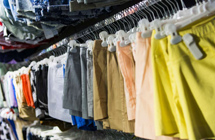为什么短裤和长裤一样贵?
|
精打细算的妹子有时候可能会犯嘀咕:为什么短裤往往和长裤一样贵,小孩的衣服和大人的衣服一样贵,甚至更贵?没道理啊,明明用的布料少那么多!难道是商家故意宰客吗?非也。今天我们就来讲讲这种定价背后的道理。 Shorts may feel nice and breezy on your legs on a warm summer’s day, but they’re not so gentle on your wallet. In general, a pair of shorts isn’t any cheaper than a pair of pants, despite one obviously using less fabric than the other. So what gives?
It turns out clothing retailers aren’t trying to rip you off; they’re just pricing shorts according to what it costs to produce them. Extra material does go into a full pair of pants but not as much as you may think. As Esquire explains, shorts that don’t fall past your knees may contain just a fifth less fabric than ankle-length trousers. This is because most of the cloth in these items is sewn into the top half. Those same details that end up accounting for most of the material—flies, pockets, belt loops, waist bands—also require the most human labor to make. This is where the true cost of a garment is determined. The physical cotton in blue jeans accounts for just a small fraction of its price tag. Most of that money goes to pay the people stitching it together, and they put in roughly the same amount of time whether they’re working on a pair of boot cut jeans or some Daisy Dukes. This price trend crops up across the fashion spectrum, but it’s most apparent in pants and shorts. For example, short-sleeved shirts cost roughly the same as long-sleeved shirts, but complicated stitching in shirt cuffs that you don’t see in pant legs can throw this dynamic off. There are also numerous invisible factors that make some shorts more expensive than nearly identical pairs, like where they were made, marketing costs, and the brand on the label. If that doesn’t make spending $40 on something that covers just a sliver of leg any easier to swallow, maybe check to see what you have in your closet before going on your next shopping spree. |









